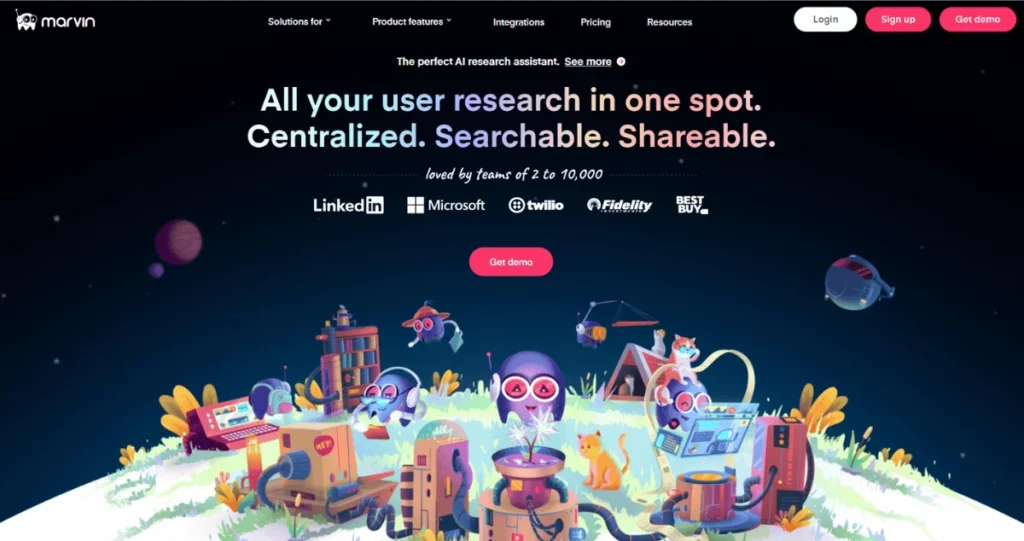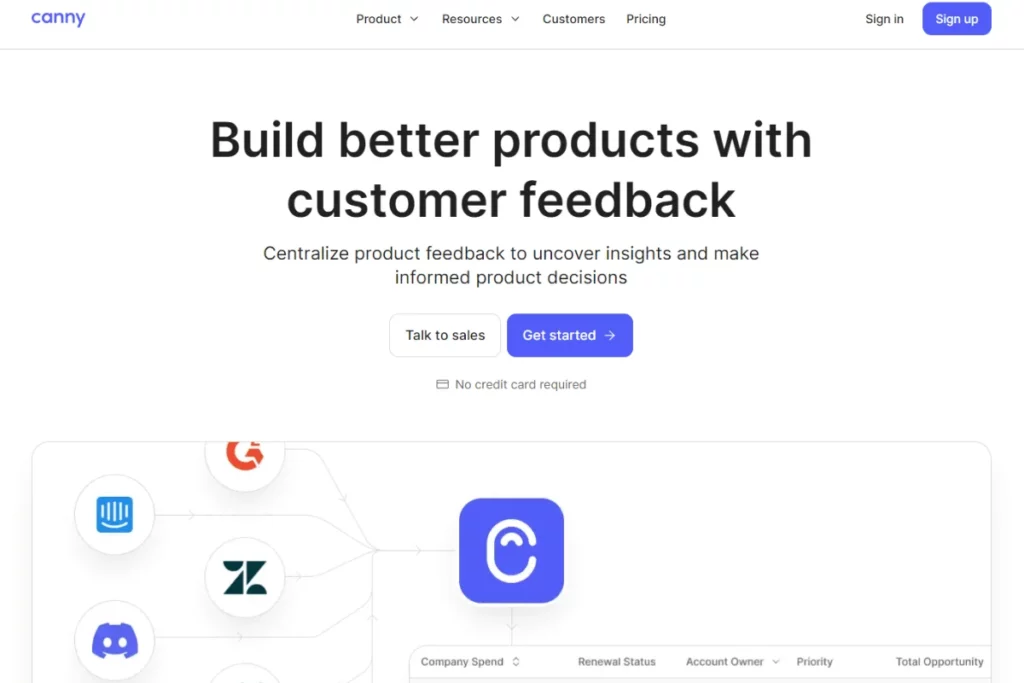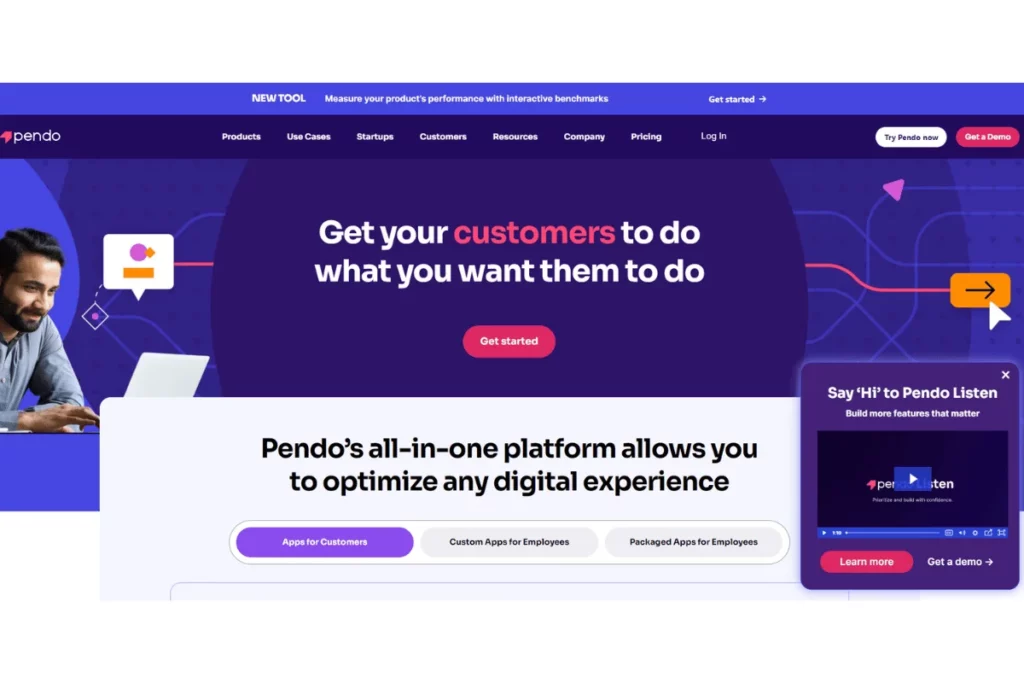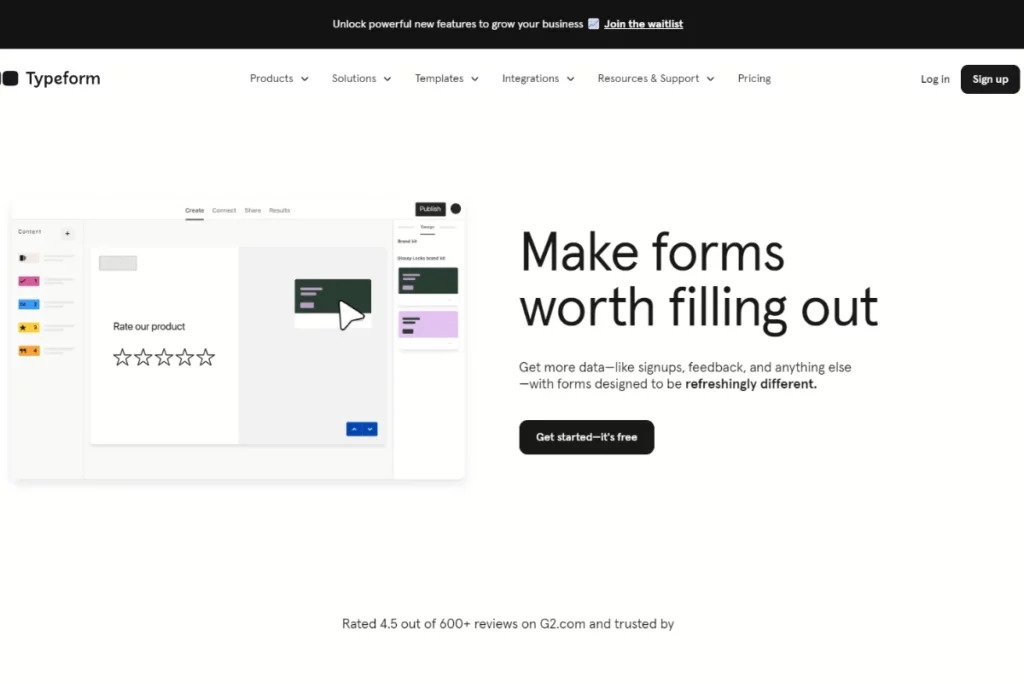Google Glass. Segway. Why did these promising products fail?
They didn’t bother trying to understand what their customers or users really needed using product feedback tools.
A grave mistake.
A constant feedback loop helps businesses understand customer motivations and frustrations.
So, how do businesses collect customer feedback on an ongoing basis?
They use Product Feedback Tools.

TL;DR – 7 Product Feedback Tools
User feedback helps UX professionals create experiences that customers love. In this article, we’ll closely examine the best tools for customer feedback:
- HeyMarvin
- Canny
- Hotjar
- Pendo
- Qualaroo
- Typeform
- Userpilot
The frontrunner…you might ask? HeyMarvin helps you distill honest feedback into accurate insights about what makes your customers tick.
Build exactly what they need with Marvin. Set up your free demo today.

What Are Product Feedback Tools?
User feedback is essential to understand customer needs and pain points.
Product feedback tools are applications or software that help product teams collect, organize, and analyze user feedback.
They help designers and product teams improve the user experience. By measuring customer satisfaction, teams make informed decisions about a product’s direction.
Gain a deeper understanding of different customers.
Here are some benefits of implementing tools for feedback into the research process:
- Improved Product Features. Target user needs with feature updates and launches. Informed decisions help dictate the next steps.
- Bug Detection. Catch bugs or glitches before they escalate. Get instant testing feedback about prototypes.
- Measure Customer Satisfaction. Garner insights from customers. Understand how you stack up against the competition.
Customer feedback tools enhance the overall user experience so teams can create products that users love.

What to Look for in a Product Feedback Tool
Choosing the right tool for customer feedback isn’t a straightforward task. Each business has different requirements and use cases.
Look through these essential features to prioritize needs for your product feedback tool:
- Feedback Collection & Aggregation. The tool must create surveys or feedback forms. Some tools have widget capabilities — a feedback pop-up appears baked on an event or action. Collect and analyze all your feedback in one place.
- Advanced Data Analysis & Reporting. Facilitate user segmentation. Separate customers by various attributes, scores, behavior, and other interactions. This allows tailored product and marketing strategies. Sentiment analysis is a bonus feature.
- Tagging. A hefty amount of qualitative analysis involves tagging data. Make sure the tagging facility is intuitive and easy-to-use.
- Customization. Look for tools that allow you to create tailored surveys and reports.
- Searchability. Studies often have important takeaways. Over time, these get lost in the ether. Look for tools that let you search the entire research repository and use insights across projects.
- Integrations. Ensure the tool integrates with your existing tool stack. Automate data flow between applications so research teams can spend more time focusing on data analysis rather than data management.
- Shareability. This one is twofold. Look for tools that:
- Disseminate feedback forms or surveys through various customer-preferred channels.
- Allow quick sharing of feedback or reports to people across an organization.
- User-Friendliness. A complicated tool is no good for anyone. One that requires hundreds of hours before mastery will deter most people. Look for tools with an easy-to-navigate user interface. Ones that aren’t difficult to pick up for newbies.
7 Product Feedback Tools To Gather User Insights
Confused about where to begin your search?
We’ve got you covered.
Here’s a look at the best tools for feedback. Included are some of their most nifty features and uses for each tool:
1. HeyMarvin

An all-in-one research platform. HeyMarvin houses both qualitative and quantitative data, so your customer feedback lives under one roof. Use its powerful AI features to conduct thematic, sentiment, or trend analyses on your data.
Trace user insights back to exactly what users said. Visualize user feedback and create insightful and interactive reports to communicate value easily and effectively.
Features
- Centralized Repository. Surveys, audio, video, PDFs, and more — add any file format at Marvin. All your research artifacts are in one place. Search your entire history of user feedback across projects. Searchability supercharged.
- Survey Tool. End-to-end survey management. Manage your user interview panel and recruit participants. Analyze thousands of survey responses in minutes. Import surveys and use Marvin’s automated NPS analysis to get insights faster.
- Advanced AI. Automated tagging and analysis capabilities conduct a preliminary round before you begin your own analysis. Ask AI allows you to ChatGPT user feedback data. Interrogate and ask questions about your feedback data. Use Marvin’s AI to unearth patterns that you might miss.
- Shareability. Stitch together clips and highlight reels into interactive reports. Share these with stakeholders via Slack or your tool of choice.
- Secure Data. Marvin is SOC2, GDPR, and HIPAA compliant. Use privacy filters to scramble your user data. Sensitive user data is safe and secure within Marvin.
- Integrations. Marvin integrates seamlessly with apps that designers love. Into your existing workflow, it fits like a glove. We couldn’t resist the rhyme.
You can speed up the user research for your whole team with Marvin. Book a demo here to learn how!
2. Canny

An interactive user feedback management platform that’s built for B2B companies. Canny helps companies track and house customer and teammate feedback in a centralized location. Facilitates robust, informed decision-making based on analytical data about product features.
Features
- Prioritize. The tool helps companies collect, track, and prioritize customer feedback. Researchers can identify which customers want certain features.
- Community. Customers can view other people’s suggestions. They can help each other before customer support’s assistance is required.
- Voting. Users can submit feedback, vote on it, and comment. Think of this as a transparent suggestion box or open forum.
- Product roadmaps are made public. This feature ensures companies engage with customers, increasing trust and loyalty.
- Integrations. Canny works with several popular platforms.
3. Hotjar

An analytics platform that captures user behavior data. A visual feedback tool, Hotjar is best used for behavioral visualization and tracking.
Companies collect product experience insights in real-time. A user’s behavior is monitored while they’re immersed in a website or application.
Track customer journeys to improve user experience and engagement. A simple, uncluttered UI makes Hotjar easy to navigate.
Features
- Heatmaps. Identify areas on a web page that users gravitate towards and which ones they don’t.
- User Session Recordings. These reveal exactly how people navigate through a website. It can surface rage clicking or visible frustration which helps designers identify bugs or glitches in the UI.
- Feedback Widget. Users provide in-app feedback in real-time, sharing their thoughts or reporting bugs. They can even upload screenshots (should they have any grievances).
- Surveys & Polls. Create tailor-made feedback forms. Hotjar combines analysis and feedback into one tool. Find out how users feel about using a product. Then, analyze how they interact with web pages and applications.
4. Pendo

An end-to-end product experience platform. Pendo is a product analytics tool that tracks user activity and simplifies feedback aggregation. Capture and prioritize in-app feature requests. Look for revenue-generating opportunities with Pendo.
Features
- Roadmap Integration. Pedo integrates user feedback with your product roadmap. Track planned features and their success. Make sure user input drives product development.
- Analytics. Easily track KPIs and people’s usage across any platform. Put users into different groups based on their activity. This helps designers separate feedback into a view to cater to specific product features.
- User Segmentation. Go as granular as you need. Segment users based on activity — get feedback on specific product features. Other advanced filters include customer demographics, sentiment, and features. Target specific user segments or interactions with custom surveys.
- In-App Feedback Tool. Helps collect customer requests directly in-app without interrupting the user experience. In-app guides help increase awareness of new or lesser-known product features.
- Mobile App Feedback. Collect feedback from mobile apps to cater to users who interact more with mobile devices.
5. Qualaroo

An advanced product feedback platform that works best for UX feedback & surveys. Qualaroo is a beast at collecting input from product prototype testing.
Add surveys directly in design templates while testing various wireframes to provide contextual insights about user experiences.
Features
- In-Product Surveys. These let you gather feedback from users while they’re immersed in the website or application. With a higher response rate, on-page surveys accurately capture user sentiment. Engage with customers based on their actions on a website.
- Nudge Feature. Send surveys based on user actions (pages visited, how long they stay, and number of visits on a specific page)
- Survey Personalization. Add Branching logic to tailor questions to answered questions. Use skip logic to better structure your surveys. Open-ended questions help you gather free-form feedback.
- Insight Capture Tool. Ask the right questions at the right time. Segment customers based on pricing tier, customer tenure, and trial period. Send the right questions to the right audience.
- Sentiment Analysis. AI-based sentiment analysis can gauge sentiment behind textual data.
6. Typeform

A popular platform that allows researchers to create and share surveys, forms, polls, or questionnaires.
Publish surveys or product feedback forms within software or apps. Gather feedback from any stage of the user journey.
Typeform shows one question at a time to enhance the survey experience for users.
Features
- Interactive Interface. A user-friendly interface and form editor that lends itself to the design process.
- Conditional logic. Direct questionnaires based on previous answers. Ideal for narrowing down insights.
- Extensive Library. Numerous pre-built templates with a library of photos and videos can be embedded into surveys. Create surveys with unlimited questions and answers.
- Chatbot Builder. This no-code chatbot builder helps guide users. Once programmed, the chatbot responds automatically.
- Integrations. Generate and share reports easily with team members via project management software. Embed surveys directly on websites or share via social media or email. Typeform integrates with a variety of business tools.
7. Userpilot

A product growth feedback and UX tool. The application has a wide array of survey options. Researchers can collect in-app feedback (in real-time) to look at product metrics at each stage of the user journey and understand usability issues.
- Survey creation. Create surveys from scratch or browse their library of templates. These include product-market fit, customer effort score and customer satisfaction score.
- Event Triggers & Automations. Follow interactions with surveys to capture real-time user insights.
- NPS Processing. Capture customer satisfaction metrics. Use data to drive product improvements. An NPS dashboard helps you identify recurring patterns and themes.
- Survey Localization. Translate survey content based on a user’s location. This improves their overall experience and brings accurate insights.
- Survey analytics. Userpilot monitors the page a customer is on. Track & analyze customer data from the end-to-end user experience. Visualize and analyze user feedback data. It even boasts sentiment analysis.
Frequently Asked Questions (FAQs)
Below, we address some frequently asked questions about product feedback tools:
Can Product Feedback Tools Help in Product Development?
You bet they can!
Gathering feedback continuously helps product teams better understand customer needs. Users share their expectations and experiences while using a product.
Feedback reveals what users love and don’t love about a product with actionable data.
Testing can uncover bugs or glitches. Users share product feature requests to indicate what they’d like to see.
Using customer feedback, designers can prioritize changes based on different levels of urgency. A shorter feedback loop allows for faster turnaround and further product innovation.
Overall, tools for feedback help drive continuous discovery and improvement in a product. Make more customer-centric decisions.

How Do Product Feedback Tools Handle User Privacy and Data Security?
Protecting a user’s Personal Identifiable Information (PII) is critical.
Product feedback tools incorporate several measures to safeguard user privacy and data security:
- Encryption protocols. Encryption scrambles sensitive data and makes it unintelligible during data transmission and storage.
- Compliance. Ensure that the tool adheres to industry standards and regulations for data protection.
- Security audits. Tools periodically perform audits and updates to remain compliant with evolving data regulations.
- Access controls. Restrict unauthorized access to user data.
When auditing a tool, ensure it has robust data security protocols. User privacy features help establish customer trust.
Marvin is HIPAA, SOC2, and GDPR compliant. Your user data always stays protected.
What Are The Latest Trends in Product Feedback Tools?
Product feedback tools have evolved dramatically over the last couple of decades.
Look out for these innovative features when selecting a tool:
- AI Insights. Jump on the AI UX research train. Tools offer advanced AI and machine learning to help researchers identify patterns and trends in data. This offers insight into customer preferences and behavior. Let AI give your data the ‘once over’ before beginning analysis.
- Analytics and Visualization. Examine your data closely with advanced analytics and visualization tools. Product feedback tools facilitate trend analysis and data visualization with charts and graphs. Generate reports and share your findings to act on customer insights.
- Powerful Integrations. Don’t uproot your entire workflow to accommodate a feedback tool. Tools seamlessly integrate with your existing workflows and toolstacks. Worry about what to do with the data, not how the data will get there in the first place.
- Real-time Feedback. Tools now offer real-time integration with platforms to collect data instantly. View what your customers are doing and how they are responding, LIVE. Facilitates agile development and shorter product iteration cycles.
- Mobile-App Compatibility. Nowadays, people prefer using their mobile devices and apps. Is the tool or survey accessible on a phone? Collect feedback on the go with this handy feature.
Which trends add value to your research practice?

Conclusion
Meaningful user feedback helps develop user empathy. Design and research teams gain a deeper understanding of customers’ needs and motivations.
Product feedback tools help companies unearth valuable insights. They equip designers and researchers with actionable data to improve their products. Customer insights dictate changes that enhance the overall user experience.
However, choosing the right tool for feedback is no easy feat.
At Marvin, we strive to help our customers build a user-centric culture. We’d love to understand more about what your business is looking for in a product feedback tool. Get in touch with our team today.
Thank us later.




